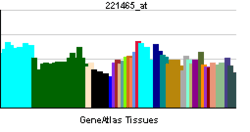OR6A2
Olfactory receptor 6A2 is a protein that in humans is encoded by the OR6A2 gene.[3]
Function
Olfactory receptors interact with odorant molecules in the nose, to initiate a neuronal response that triggers the perception of a smell. The olfactory receptor proteins are members of a large family of G-protein-coupled receptors (GPCR) arising from single coding-exon genes. Olfactory receptors share a 7-transmembrane domain structure with many neurotransmitters and hormone receptors and are responsible for the recognition and G protein-mediated transduction of odorant signals. The olfactory receptor gene family is the largest in the genome. The nomenclature assigned to the olfactory receptor genes and proteins for this organism is independent of other organisms.[3]
Clinical significance
Variation in the OR6A2 gene has been identified as a likely cause of some people's strong dislike of coriander (also known as cilantro), often associating it with a combination of soap and vomit, while for others it is closer to the foul smelling odor emitted by stinkbugs. This is due to the presence of aldehyde chemicals, which are present in soap, various detergents, coriander, several species of stinkbugs and cinnamon.[4]
See also
References
Further reading
- Buettner JA, Glusman G, Ben-Arie N, et al. (1998). "Organization and evolution of olfactory receptor genes on human chromosome 11". Genomics. 53 (1): 56–68. doi:10.1006/geno.1998.5422. PMID 9787077.
- Lane RP, Cutforth T, Young J, et al. (2001). "Genomic analysis of orthologous mouse and human olfactory receptor loci". Proc. Natl. Acad. Sci. U.S.A. 98 (13): 7390–5. doi:10.1073/pnas.131215398. PMC 34679
 . PMID 11416212.
. PMID 11416212.
- Strausberg RL, Feingold EA, Grouse LH, et al. (2003). "Generation and initial analysis of more than 15,000 full-length human and mouse cDNA sequences". Proc. Natl. Acad. Sci. U.S.A. 99 (26): 16899–903. doi:10.1073/pnas.242603899. PMC 139241
 . PMID 12477932.
. PMID 12477932.
- Malnic B, Godfrey PA, Buck LB (2004). "The human olfactory receptor gene family". Proc. Natl. Acad. Sci. U.S.A. 101 (8): 2584–9. doi:10.1073/pnas.0307882100. PMC 356993
 . PMID 14983052.
. PMID 14983052.
- Gerhard DS, Wagner L, Feingold EA, et al. (2004). "The Status, Quality, and Expansion of the NIH Full-Length cDNA Project: The Mammalian Gene Collection (MGC)". Genome Res. 14 (10B): 2121–7. doi:10.1101/gr.2596504. PMC 528928
 . PMID 15489334.
. PMID 15489334.
External links
This article incorporates text from the United States National Library of Medicine, which is in the public domain.
|
|---|
|
Class I
(fish-like specific receptors) | Family 51 | |
|---|
| Family 52 | |
|---|
| Family 56 | |
|---|
|
|---|
|
Class II
(tetrapod specific receptors) | Family 1 | |
|---|
| Family 2 | |
|---|
| Family 3 | |
|---|
| Family 4 | |
|---|
| Family 5 | |
|---|
| Family 6 | |
|---|
| Family 7 | |
|---|
| Family 8 | |
|---|
| Family 9 | |
|---|
| Family 10 | |
|---|
| Family 11 | |
|---|
| Family 12 | |
|---|
| Family 13 | |
|---|
|
|---|

 . PMID 11416212.
. PMID 11416212. . PMID 12477932.
. PMID 12477932. . PMID 14983052.
. PMID 14983052. . PMID 15489334.
. PMID 15489334.